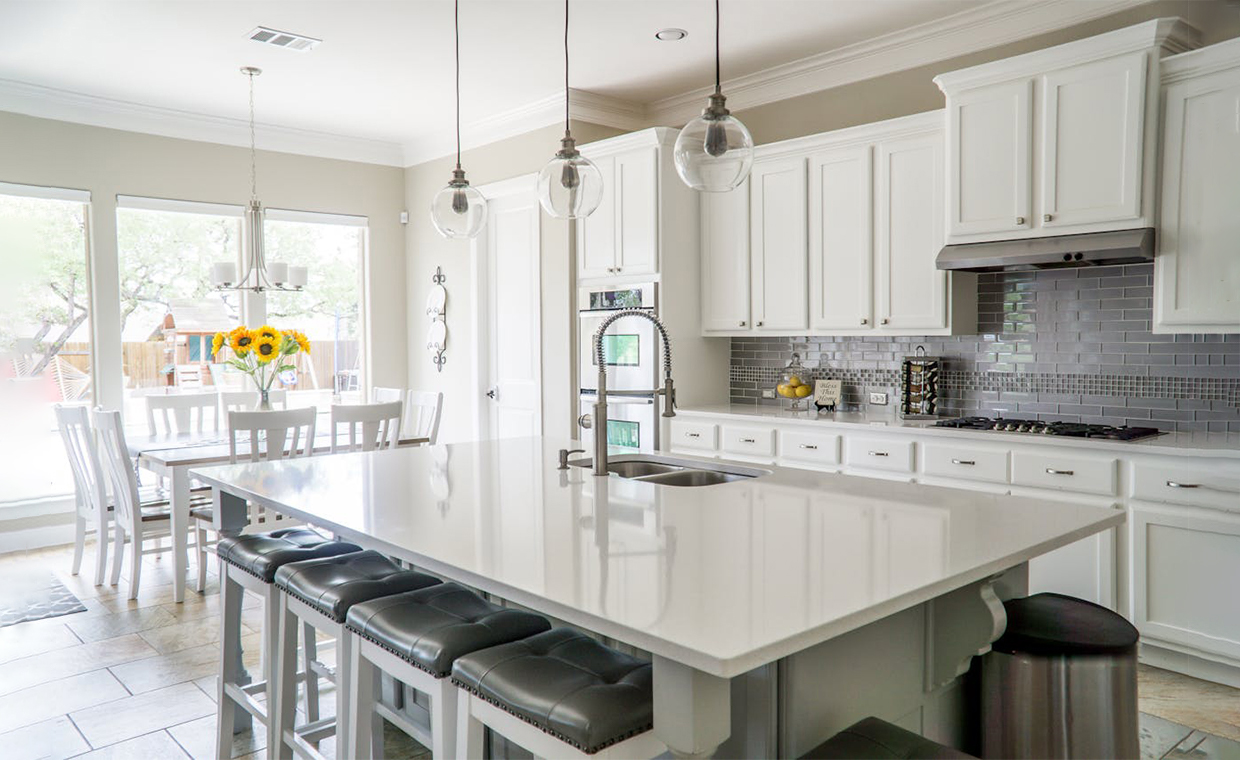
We all know panelling a wall is once again getting popular and in trend these days compared to wallpapering, painting, and cladding with tiles. ‘Panelling’ not only aims at concealing the flaws of the walls, but also gives a fresh feel and stylish look to the room. In other words, concealing process is nothing but beautifying the room by panelling the walls.
‘Panelling’ is a decorative treatment of walls and ceilings consisting of a series of wide, thin sheets called panels, framed together by narrower or thicker strips of wood, synthetic materials, glass or other materials. Decorative panels of various shades, texture, finishings, etc. can be utilized to glamorize the ambience of the room.
According to ‘Y.M.D Adedeji and B. Ajayi’, (published in Cost-effective composite Building Panels for Walls and Ceilings in Nigeria)‘ Wall panels are vertical elements in a building that serve the function of walls. They are convenient and practical whether used for functional purposes or simply as an aesthetic element. As a decor element, wall panels are an excellent way to break up wall space.’
The panels used for decoration comes in a variety of shades, textures, finishings, materials, shapes and sizes. Depending upon the material and the quality of material used; the aesthetics, the strength, the hygiene, and maintenance of such panels keeps differing. Thus, it becomes equally essential to take into consideration all these aspects before going for wall panelling. This should ultimately facilitate in selection of an appropriate and pertinent material for your rooms.
Let us know and understand some materials available for panelling and their characteristics before choosing the one for your room.
How To Enhance And Embellish The Look Of The Walls of Your Rooms By Wall Panelling

01. Wood Finish Panelling
Paneling that is done using wood of trees like teak, mahogany, oak, walnut, etc is known as wooden panelling.
Wooden panelling can be in the form of planks, blocks or panels.
One can use wood of different size and shapes for forming a pattern of one’s choice.
A designer can explore many design options by trying different permutations and combinations of the panels.
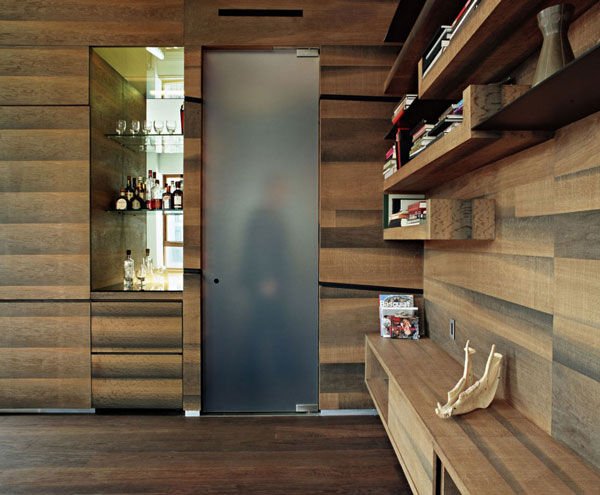
Depending upon your selection of the hardwood (i.e. teak, mahogany, oak, walnut, etc); there are various shades of wood available for wood panels.
You can try staining, painting or polishing the wooden surface to give it a variant feel. You can even try with carving or bumping or texturing the wood to give 3D effect.
A designer, therefore, can explore his creativity and enhance his horizon of imagination while using wood as a material, for achieving a decorative surface.
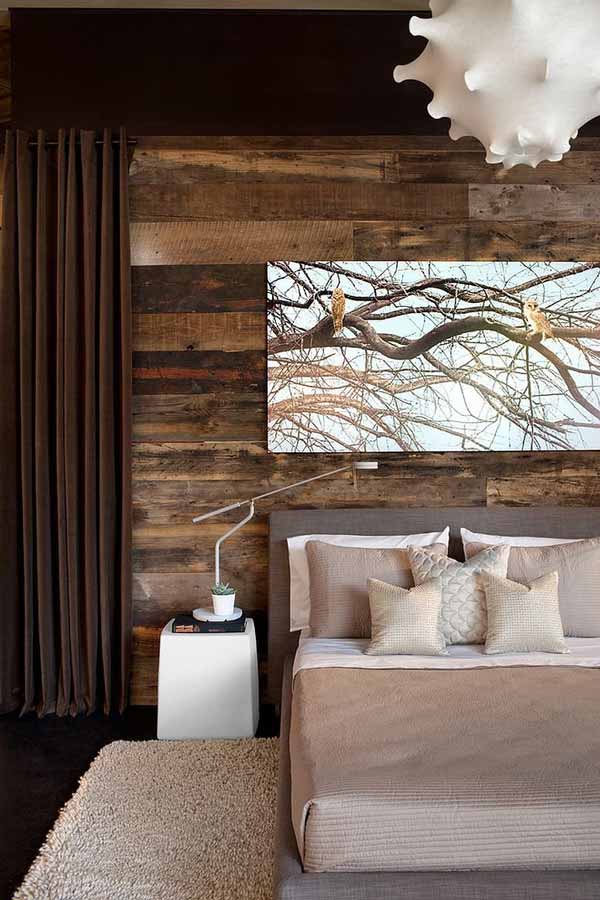
Fixing of wooden panel/planks is a simple carpentry task. One can either fix the wood panels directly on the wall surface or can fix the panels on the grid of a frame. The latter is more desirable, as it provides smooth and uniform surface to the panels.
One of the main advantages of wooden panel is that, it increases the aesthetic value of your home. The walls look rich and elegant. Wooden panels insulate the walls thermally. It also inhibits condensation. However, there are certain limitations to these panels. These panels are neither fire resistant nor water proof.
As these panels are made of wood, they can rot with time. Wooden panels are more or less vulnerable to termites. However, we can replace a panel from the system on spotting decay.
Considering the advantages, these panels are widely used in cold countries where they not only provide plush and splendid looks to the walls, but simultaneously act as a thermal insulating element.
Wooden panelling is comparatively a costly affair; hence many high-end hotels, motels, offices and houses use such panelling.
02. Veneer Panelling
Veneer is replacing wood in many interior facets. Veneer is a thin layer or slice of wood that is fixed on a backing board.
Veneer gives a ‘wood like look’ and is cheaper compared to any natural wood. Veneer panels are light weighted. Installation of veneer panels is a very quick process.
The maximum size available of veneer is 8ft x 4ft. Veneer panelling facilitates a large surface of wood panelling without grooves. Because of the vast surface available, it further facilitates designers to explore a range of designs for a wall panel. The planks of wood panels are available of width in the range differing from 2 inches to 12 inches and length up to 8 ft. It is difficult to get an exceptional big size of a wood plank, and, eventhough we may get it, it would be tremendously costly. Hence veneer panelling is preferred in most cases.
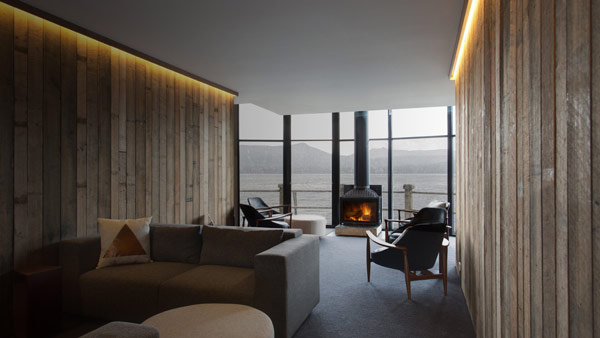
Veneers are also available in the same colour pallet of wood but with a varied grain design.
Painting or Polishing the veneers is similar to treating the wood surface.
Veneer panelling is widely used in residences, schools, auditoriums, commercial buildings, etc.
03. Laminate Panelling
Laminate is the most effective way to panel a wall surface. Fixing of such panels is similar to veneer panelling. We can glue the laminate to plyboard or WPC or any other backing board. This provides toughness and firmness to it. Later, we can screw the panels on the frames or the wall surface.
We all know that laminates are easily available sheets that come both in glossy and matt finishes. They are available in numerous variety of shades and textures.
Laminates with wood finishes are very much in trend these days. Laminates give wood ‘feel’. They almost replicate the Veneer surfaces. But they are much cheaper compared to the Veneers.

It is easy to clean a laminate. Thus, it offers better hygiene and low maintenance. Laminates withstand weather, moisture, chemicals, etc. Hence, Laminate panelling is used in toilet areas, kitchens, and even hospitals nowadays.
04. MDF Panelling
Medium density fiberboards are similar to ply boards but they have separated fibres bound by resin. Medium-density fiberboard (MDF) is generally cheaper than plywood, but it is not as hard and can sink under heavy weight. These boards are available in plain, textured finishes with varying thickness. Their surface can easily be painted by using regular plastic paint.
The fixing of thinner MDF sheets is similar to laminate. The MDF board has to be nailed to ply board/ WPC or backing board. They are available in 8ft x 4ft size. However, you need to provide a groove of minimum 3mm to avoid a crack on the painted surfaces.
There are 3D Panels of varied shapes and figures available in this material. There are textured wall panels, Sculptured wall arts and decorative jalis available in MDF panels.

These boards are moisture sensitive. They work best when moisture content remains low. These are not water resisting board and can swell eventually. Finishing treatment is necessary for such boards.
They offer an appealing decoration to a room and thus are used in bedrooms, living room, offices, hotels, etc.
05. PVC Panels
The Polyvinyl Composite panels usually have a hollow core and are lightweight with a smooth surface for decoration and a tongue-and-groove system for easy installation. These panels are easy to cut hence it becomes easy to work on such panels. They are like pre-laminated type panels directly fixed on the frames.
The PVC panels are very easy to maintain. These panels are long lasting, fire resistant, hygienic, and durable.
The PVC panels are available in glossy and matt finishes. They have a protective lacquer layer that resists dust. These are waterproof and easy to clean.
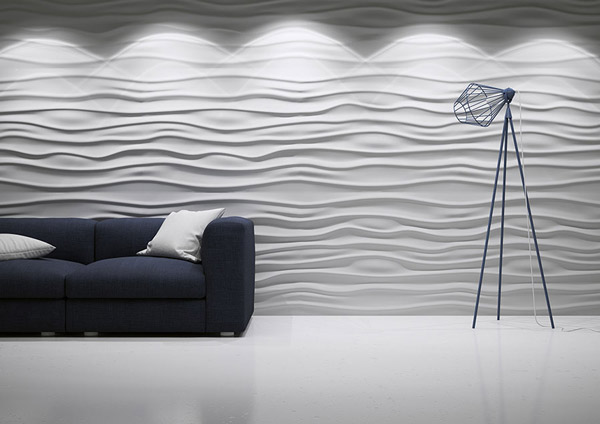
Also, these panels are inexpensive and easily available. They are available in bright colours and 3D patterns. They are used in schools, hospitals, kitchens, etc. PVC panels are soft and flexible, hence are preferred in the areas pertaining to kids.
06. Gypsum Panelling
Gypsum board is such a material that not only function well as a stand-alone building insulation material but works well as a barrier against ignition. It also holds high strength properties. Thus, because of these pecularities, Gypsum board panelling is commonly and widely used. These panels are also easy to install.
One can paint a gypsum panel as per the interior theme. Alike in MDF panels, there are numerous textures available in gypsum panel too.
Gypsum panels are available in 4ft width sheets and 8ft to 10ft long. The larger the size of panels, the more it gives flexibility to the designer to explore better options.
Gypsum panels are also available in 3D textures like the one shown in the image below.
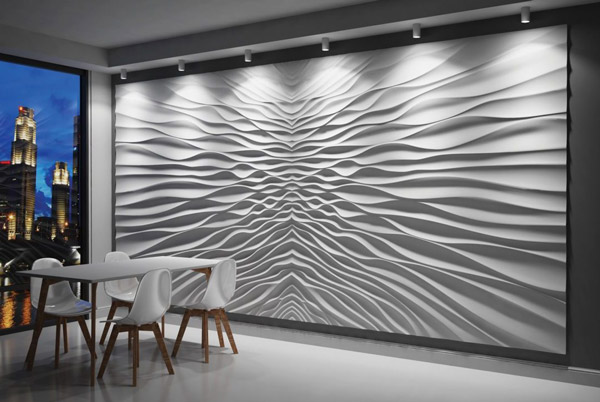
They are used largely in offices and commercial buildings because of the fire resisting properties.
Also Read:
Gypsum Board: All You Need to Know!
Types of Gypsum Board | All you Need to Know
07. Fabric Panelling
Fabric panels give the walls a softer feel. We can directly glue the fabricon a smooth backing board or wall. We can use materials like polyester, jute, leather, etc. for fabric panels. Although, there are readily available fabric panels which can be directly fixed on the frames.
Fabric panels act as sound insulators or rather acoustical materials. Acoustical materials primarily perform one of the two functions – they either absorb sound or they block its transmission; depending upon the desired objective. Hence, such fabric panels are used in theatres, auditorium etc.
According to ‘Y.M.D Adedeji and B. Ajayi’, (published in Cost-effective composite Building Panels for Walls and Ceilings in Nigeria)‘ fabric wall panel is made from heavy fabric such as canvas, and can be easily hung in a matter of hours to cover unfinished ceilings and walls, giving any space a clean, refined look.’
The fabric panel with a low-density fiberboard is usable as a soft board for your room. Such systems are used in schools, classrooms, children’s rooms, etc.

The only disadvantage with it is; the fabric gets dirty and it is difficult to clean it. However, there are fabric panels available in the market that can be washed or such panels that can be replaced too.Thus, there are various range of materials available for wall panelling and you can opt for the one as per your requirement. Now that, when we have briefed you about these materials, we would request you to list down your requirements or anything specific/particular you would expect for your space. Choose the look/ finish available in those materials OR make permutations and combinations of your choice with those materials or finishes.
Shown below is a marvelous example of PVC art wook on a black coloured wood textured panelling. Please, have a look . Now, doesn’t this looks interesting?
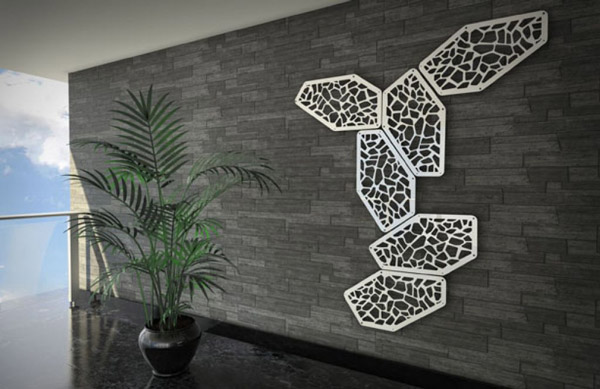
Please feel free to share with us, the design and ideas that clicks your mind. Please, also do share with us the material you like the most AND forget not to mention the reason for the same!
Also Read:
Plywood vs Blockboard: How to Make the Right Choice
MDF vs Plywood: Make The Right Choice
Solid (Natural) Wood vs Plywood vs Blockboard vs HDF vs MDF vs Particle Board: Make the Right Choice of Engineered Wood
Image Courtesy: Image 1 – midcityeast, pImage 5 – wood2u, Image 6, Image 8 – wallset, Image 10 – sshome
Author Bio
Urnit Kaur – Urnit Kaur is an Architect based in Ahmedabad. She loves Design challenges and it helps her client’s to bring their thoughts into reality. She has been passionately involved in Architecture from designing projects to managing them on site since 2014. She has been part of Ahmedabad Heritage Dossier project, designing ISRO Bopal campus and currently working on other varied scale projects with Aakruti Architects. With her rich experience in fieldwork, she shares tips and facts in her blogs about Architecture, Interior and MEP services. She believes learning should never stop, so she has developed a hobby of creating colorful home décor items by experimenting different materials and aesthetics.



























